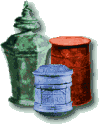Cosmetics
As the matrona began her day, a slave
girl removed her mistress' night cream, concocted from wheat flour and asses'
milk, or crushed snails. Some facial creams were
crafted of more expensive ingredients: Libyan barley, honey and narcissus
bulbs, and crushed stag's antlers.
Some even contained dangerous poisons, like mercury or lead, not only
risking a vain woman's skin, but her life as
well.
 Nero's lover, then wife, the beautiful and vain Poppaea was
famed for developing her own beauty cream fabricated from
dough and ass's milk. She kept 500 head of donkeys, which were
herded along on her travels so she could bathe in their
milk! Nero's lover, then wife, the beautiful and vain Poppaea was
famed for developing her own beauty cream fabricated from
dough and ass's milk. She kept 500 head of donkeys, which were
herded along on her travels so she could bathe in their
milk!
The matrona then cleaned her teeth with a toothbrush and
dentifrice, then soaked in perfumed bath water, which she
also might do after attending the baths to counteract body
odour. Scents and fragrances were popular enough to draw the
attention of Pliny, who carped that a million sesterces were
drained away to the Far East in buying scent for Roman ladies.
 A masseur, or unctor
massaged his mistress' skin with precious unguents, often
using a different one for each part of the body.
Women who could not afford such expensive scent anointed themselves
in olive oil scented with flowers. A masseur, or unctor
massaged his mistress' skin with precious unguents, often
using a different one for each part of the body.
Women who could not afford such expensive scent anointed themselves
in olive oil scented with flowers.
After styling her mistress' hair, an
ornatrix
used white chalk or white lead powder
on her and arms, then applied a rouge made from
red ochre or the dregs of red wine to the
lips and cheeks. Eyes were outlined with Egyptian kohl, powdered
ash and saffron, and eyebrows and lashes were darkened with burnt cork.
All these ingredients were at hand in
pyxides — vases and jars — on a
nearby nightstand, which doubtless held a mirror made of
polished bronze, copper or silver, or glass backed with lead.
Sources: I CLAVDIA: Women in Ancient
Rome, Kleiner and Matheson, Yale University Art Gallery,
1996
I CAESAR, Ruling the Roman Empire , Phil
Grabsky, BBC Worldwide Publishing, 1997
Updated
|
